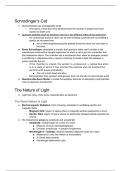Class notes
CHEM 130 Chapter 2: Quantum Mechanical Model
- Course
- Institution
Class notes for Chapter 2: Quantum-Mechanical Model in the class General Chemistry: Macroscopic Investigations and Reaction Principles (CHEM 130) at the University of Michigan. Subjects covered include wave natures of light and matter, electromagnetism, diffraction, the particle nature of light, Bo...
[Show more]



